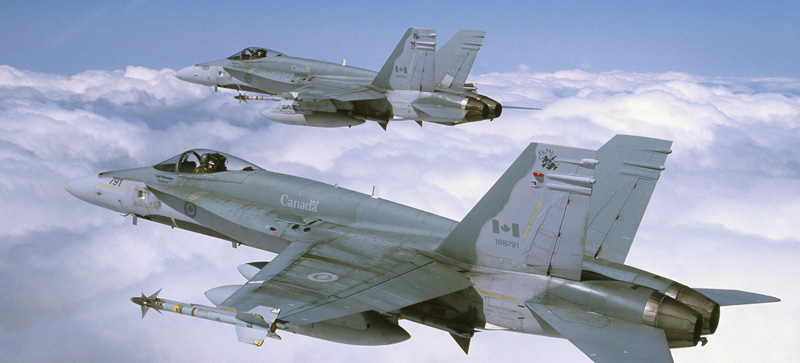April 25, 2016
As Canada's Defence Review gets started the debate as to which fighter should replace the Royal Canadian Air Force's aging CF-18 Hornet's continues - despite the fact that much of the budget for their replacement has been postponed until after 2021. Something that could cause major problems for the RCAF.
The CF-18s are going through another life extension to keep the fleet air-worthy until 2025; but that is based on a 5 year acquisition rate of a new fighter; which would mean a contract awarded sometime soon - and not in 2021-2022 as the current budget figures would seem to show. According to senior members of the RCAF; if the current life extension is not complete by 2021, it is not economically viable - as more upgrades will be needed. Just because this extension date is 2025 - does not mean the fleet will be retired in 2025; but the risks get much higher when flying a combat aircraft over 40 years old. If the entire fleet is retired in 2025, the oldest aircraft will be 43 years old.
But according to the RCAF plans are in place for a 2025-2030 life expectancy plan for the ageing CF-18s.

The CF-18 Hornet entered service in 1982 as a multirole fighter/interceptor replacement for the CF-5 Freedom Fighter, the CF-101 Voodoo and the CF-104 Starfighter. The Hornet fleet’s Estimated Life Expectancy (ELE) was initially set to 2003, which represented a service life of 20 years after the declaration of Initial Operational Capability. This value was based upon projected initial usage when calculated against the original equipment manufacturer’s certified design life.
In the case of the CF-18 fleet, early structural lifing concerns led to the implementation of a structural fatigue life management program (FLMP) in 1988, and a collaborative full-scale structural fatigue test program with the Royal Australian Air Force (RAAF) to re-certify the CF-18’s design life based on Canadian and Australian usage. This collaborative effort was known as the International Follow-on Structural Test Program (IFOSTP) and was completed in 2006. Results from this test program formed the basis from which the CF-18 Hornet’s structural Life Extension Program (LEP) was developed. As the aircraft’s structural life is an airworthiness limitation, it is an important factor in calculating a realistic ELE.
The implementation of the FLMP, a LEP tailored to Royal Canadian Air Force (RCAF) usage requirements, changes to how the CF-18 was flown, and reductions in the planned yearly flying rate (YFR) over the years have all combined to extend the CF-18’s projected physical life. The CF-18 ELE was extended to 2020 with an assumed three-year overlapping transition window to a new fighter (i.e. 2017-2020) following an extensive study first started in 2004.
The problem however, is the RCAF has now entered this period; and no replacement has been chosen. Therefore, the CF-18 ELE has once again been examined to determine if it can be viably extended beyond 2020. The analysis for this report assessed the option of extending the CF-18 ELE to 2025 and 2030, using a new five year overlapping transition window to a new fighter.
An ELE of 2025-2030 represents a technically feasible albeit risky stretch target. It would require the entire fleet to undergo the Control Point 3 (CP3) Life Extension Program (LEP) along with other significant structural refurbishment investments. This option is a high risk solution, from both a technical and operational perspective.
The CF-18 was a leading edge state-of-the-art fighter when it was introduced in the 1980s and it gradually fell behind over time until during the Kosovo conflict it had reached the ‘back edge’ of coalition capability. The capability upgrades over the last 10 years have resulted in the CF-18 again being near the ‘front edge’ during the 2011 Libya operations. This capability has once again began to erode over the remainder of the Hornet’s service life as technology continues to evolve.
CF-18 fleet size has decreased 44% since the aircraft were purchased due to attrition (operational losses due to accidents) and the management decision to retire older configuration aircraft which would have required significant NRE costs to modernize to the current configuration. Current fleet size is sufficient to meet CFDS commitments; however the flexibility to withdraw significant numbers of aircraft for required upgrades has decreased significantly. Any decision to pursue lengthy and complex upgrades would result in a commitment-capability gap.
With the above information; it would seem that the Canadian Government needs to move forward on a replacement for the CF-18s, or else Canada risks entering a period with a higher attrition rate of older aircraft and a significant capabilities gap in our areal defences.
Sources:
No comments:
Post a Comment